Castleford Tigers - it’s a jungle out there!
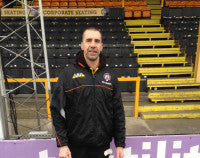
Castleford Rugby League club was formed in 1926, adopting the name 'Tigers' in 1992 when rugby league sought to improve its image to a nation of sport hungry viewers. With the sport's traditional heartland being the north of England, most notably Lancashire and Yorkshire, Castleford are firmly 'white rose'.
Castleford Tigers were founding members of the Super League in 1996, but the 21st century has seen their fortunes fluctuate, with two relegations taking them some distance away from the top flight. Now back in the Super League, 2014 saw them finish fourth and also reach the Challenge Cup final at Wembley, watched by a crowd of close to 80,000. Sadly, for them, they lost to rivals Leeds 23-10.

The club's Head Groundsman is Stuart Vause, who worked at the ground for four years part time and on match days, whilst working full time for the local authority.
"I always had an interest in turf and gardening whilst at school, so I got careers advice and was placed on a YTS scheme with Wakefield Council at the time. My dad was a massive inspiration to me, not just in encouraging me to pursue this career, but also teaching me how to work hard to get what I want."
"I worked as a team leader for the local authority for thirty years, covering cricket, bowling greens and golf, and ran a grounds maintenance team looking after two main parks; this was Monday to Friday. Then I worked at the ground after work and weekends. If I needed more time to prepare the pitch, I booked annual leave from work! Through work, I got a passion for the turf side and wanted to pursue a career in it. Now self-employed, when the opportunity came up for me to be involved with the club more heavily, I jumped at the chance," Stuart confirms.
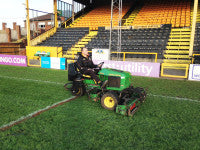
Stuart explains that the pitch is soil based heavy clay. "It holds water in certain areas after heavy rainfall, which cuts up badly from January to April. This requires lots of serious divoting and also leaves discolouration on the surface. From May onwards, it firms up, helping to cut down on the divoting. It plays heavy in the first few months of the season but, after that, is more of a delight to work on and can easily accommodate training and game days. The first few months of the year, I have to switch some under 19 games to protect the surface, decisions the club are superb in supporting. Drainage is poor as it's an old ground, so regular aeration is a must."
"I use the local authority for our tractor work (spiking/rolling/spraying) and, having worked for them for so long, retain a very good relationship. A friend of mine helps out throughout the season with large maintenance issues. We have other additional help through the season, when needed, through sponsors."
"Regular slitting and aeration is the most important thing as the pitch holds water after heavy rain. We suffer with serious flooding after heavy rain due to the ground being old and the drainage system not being able to cope. This happened in August last year; the pitch was 90% covered and it also flooded the changing rooms. It was all hands to the pump ... literally!"

"We don't currently have the budget for such luxuries as undersoil heating, drainage, lighting rigs or covers, but they would all be on my wish list."
"I report to the CEO and general manager for specific tasks, then we decide if we can move forward with them. I will price the job up, then, depending on costs and priority of the job, we will programme them in through the season ... if at all. With a new stadium hopefully on the horizon, I don't mind cutting a few corners at the moment."
Stuart says that the pitches are used "very often" through the season for gala days and kids tournaments. "This season, we held amateur cup finals at all age levels up to adult, plus school finals. Children's community games are held at half time on match days."
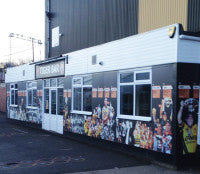
"The main pitch has decent air flow through the open ends of the stadium," details Stuart, "but suffers with shade on one side due to the length of the stand and roof. Frosts and heavy dew take time to lift and move off, which slows up our early morning starts. The training pitch is open, so doesn't suffer with anything really, except the odd rabbit!"
Stuart currently has one apprentice to assist him, twenty-two year old Rob Lilley; "he's also the club's mascot on match days!"
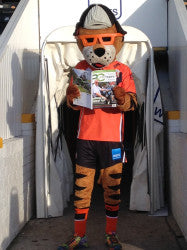
Through the non-playing winter months, the pitch is kept at 60mm.
"I will cut the stadium pitch at least three times a week during the season, and also on the day of the game, using a John Deere 2653a cylinder mower. A lot of the games are a Sunday afternoon kick off at 3.30pm but, since Sky Sport started televising the Super League, we also have Thursday, Friday and Saturday matches with 8.00pm kick offs. If that's the case, and weather permitting, we will cut on game day morning and mark out in the afternoon. That will be a lot less in winter months as the pitch gets too wet to get the mower on, so I cut with a Hayter 56 rotary."
"Marking is touched up in the week, when required, for training sessions, as the first team train on the stadium pitch in season.
Marking out is done with a spray marker and a wheel to wheel using a 4:1 mix for game day - double marked on the try lines to stand out - and 5:1 for training."
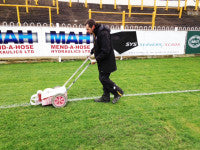
"The training pitch is cut twice a week and marked out as required. Under 19s and academy teams use the training pitch, but play on the stadium pitch for their league matches, which are on a Thursday night. If the markings are still bright after a first team game, it will be left alone; if not, the pitch is marked out on the afternoon of the game."
"After each match, the dressing rooms are swept and disinfected ready for the following morning's rehab sessions," Stuart confirms.
"Aeration takes place through the close season, when conditions allow, with a tractor mounted roller and slitter and, in season, between matches. The games start with friendlies in December or January, and the season proper starts in February. Once we are through this tricky period - with a heavy pitch requiring regular divoting after each match - from April onwards, maintenance becomes pleasurable into summer, although watering then becomes an issue as we have no sprinkler system."
"Any heavy divots will be replaced after the game and rolled but, early season, deep holes are created which require filling with a seed/soil divot mix."
"Spraying is done by tractor boom in two applications - early and mid season - if required. Any overseeding that is required through the season I try to time for when the fixtures are kind, so the seed has a chance to get hold."

"If the budget doesn't run to a full renovation - it rarely does, the main pitch hasn't had a proper renovation for over ten years - I have two tonnes of dressing delivered and patch up the best I can, targeting the worst areas. I will re-seed these areas and fertilise throughout the close season to try and thicken up what we already have. It is a massive challenge, but one I relish.
Hopefully, with a new stadium on the horizon, I don't mind cutting corners with the pitch and saving money so it can be used on a new pitch."

His optimism even stretches to seeing benefit in all the 'non-Tigers' events held at the facility. "Last year, we had amateur finals late on, which slowed renovation up a little, and also various training camps throughout the year. These can be a hindrance, but the revenue they bring in can help, and I can tap into that. We have a 'Tigers Together' group who raise money throughout the year and, last year, they bought me a pedestrian mower for clean up after games, so it can help."
Saving money is clearly important to clubs such as Castleford Tigers. There are many clubs across both codes of rugby and league football who will recognise and understand Stuart's plight, but he remains philosophical. "Last year, I brought a specialist in to test the soil, which has helped tremendously. I wanted to know the makeup of the pitch from the start. The same fertiliser had been bought for years; whether it was right or not no one knew, as nobody had thought to check. It certainly never seemed to have the desired effect! So, after the results came back, we sat down and put a proper programme together which will have a massive benefit; not only to the turf as proper nutrients are being added, but also because the club has saved money, as less applications are required."

"Monitoring the weather forecast can even alter our working week, sometimes forcing us to work late at night or early morning to get tasks done, such as cutting and marking the pitch prior to a game to achieve maximum presentation."
"They don't understand the hours a job like this needs to produce a top quality surface. People in this industry are dedicated and hard working and will go the extra mile to get the best presentation possible. Unfortunately though, the extra hours go unnoticed and what we achieve becomes 'expected'. No sporting event can make money or take place without a playable surface, and the perfect surface can be the difference between winning and losing."
"I also don't think clubs give enough money to the grounds as they save it for more, so called, important things. If anything has to give, it always seems to be our side. This inevitably makes the job harder. Clubs need to be aware that, without a top quality surface, there will be no game."

"This is a great industry to work in, but we need to get people outside it to understand what we do, especially those that hold the purse strings. We need to get youngsters involved, have open days at clubs and give people a chance to try it out."
"Let's have more seminars and shows, but advertise them more widely so that we can be seen by a wider audience. Encourage groundsmen to show pictures of their work on social network and get the fans involved. It does work, as I found out last season. I was amazed and couldn't believe the response I got."
"Have regular surveys, get opinions from the people that matter on the front line. We need to get professional clubs more involved, giving people opportunities to gain experience in the industry, whether it's short term or open days. If people can get behind the scenes, it will make all the difference, as it did for me. Organise Q&A sessions to spark interest; we have them at Castleford, covering all aspects within the club. We need to put ourselves out there!
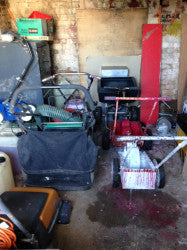
John Deere 2653A cylinder ride-on mower
Sprayer marker and wheel to wheel marker
Hayter 56 rotary mower
Stihl FS400 brushcutter
Knapsack sprayer
Stihl backpack blower
Billy Goat vacuum/sweeper
"All machinery is purchased outright, although we've only bought the one mower since I've been working here - the Hayter 56, which has helped tremendously, saving time after games collecting debris, instead of doing it by hand. It's also very good at taking the long stalks off in the summer."
"Servicing is carried out by a friend of the club who has his own business - he does a fantastic job."
"Do I have a wish list? How long have you got?"
